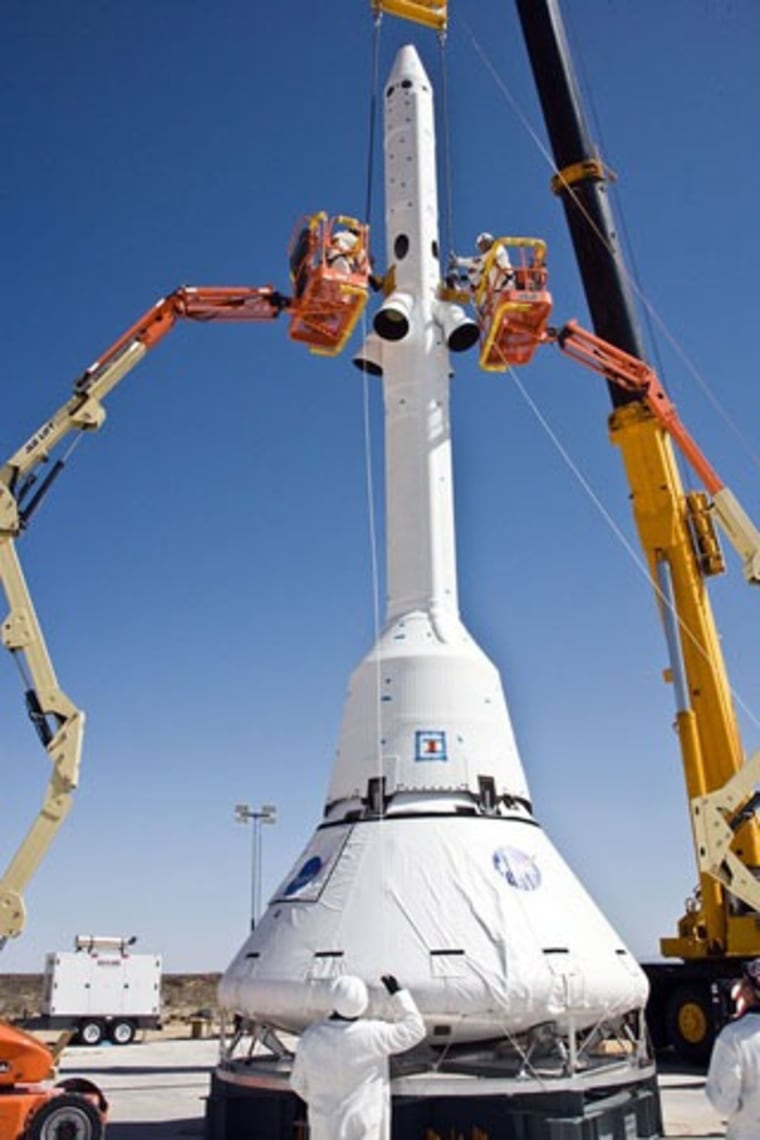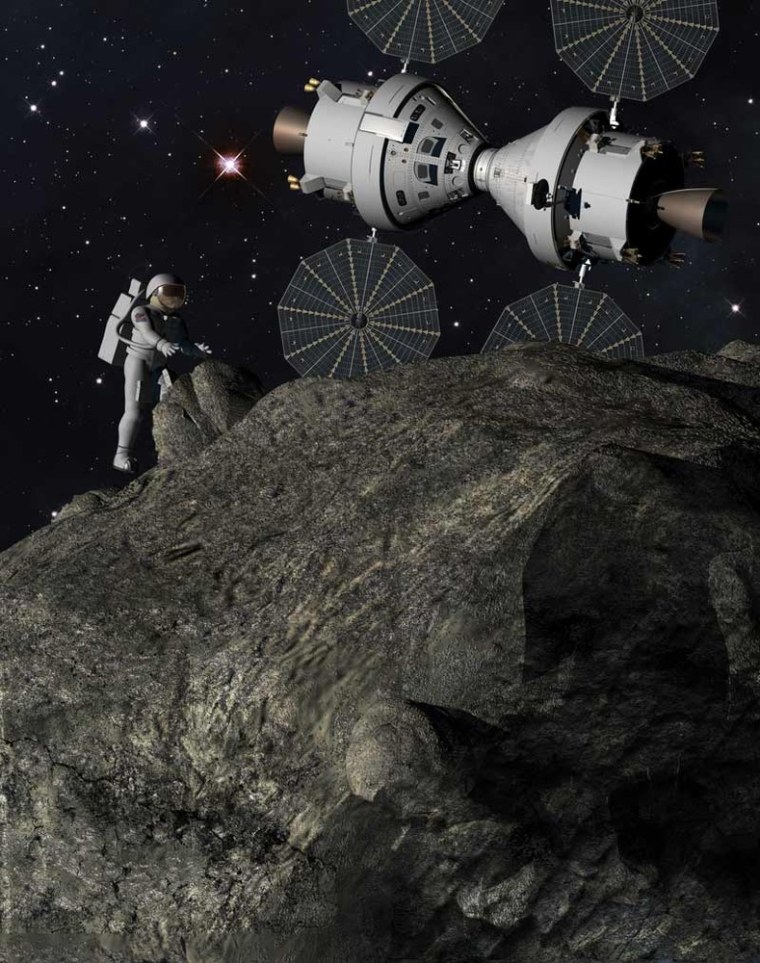NASA's new Orion space capsule is steadily coming together in preparation for a 2013 test flight, even though neither its funding nor its mission is set in stone.
The capsule's manufacturer, Lockheed Martin, is gearing up its Orion production facility in Florida, says it can complete a working version by the end of 2012 and is even drawing up its own scenario for flying the spacecraft to an asteroid.
Orion was originally envisioned to be part of the Constellation program, NASA's successor to the space shuttles. The 21,000-pound (9,500-kg) capsule would have been used to send astronauts back to the moon and to ferry people and supplies to and from the International Space Station.
However, in his 2011 budget proposal, President Barack Obama called for canceling Constellation and urged NASA to work instead toward sending humans to an asteroid, then to Mars.
Obama later recommended continuing the — but only as an escape craft that could carry astronauts home from the space station in an emergency. More recently, bills in both the House and Senate have called for Orion to be revived. The House is expected to vote on a bill for NASA's future plans Wednesday (Sept. 29).
Amid all this uncertainty, NASA's prime contractor for Orion, Lockheed Martin, is carrying on. The company, which secured the NASA contract in 2006, continues to build the spaceship, test its various components and plan out some of Orion's possible missions.
All of this is in preparation for a test launch in 2013 that may or may not take place.
"We're highly confident that's going to happen," Cleon Lacefield, the Lockheed vice president who is Orion program manager, told SPACE.com. "We've made a lot of progress. We've stayed on schedule and on budget."
Building through the uncertainty
Lockheed Martin started up mock manufacturing and assembly procedures for Orion this month (September) at a facility at NASA's Kennedy Space Center in Florida.

The activities, which use a full-scale model of the space capsule, are a test run to make sure everything checks out before a spacebound Orion capsule is built at the facility, officials said.
Orion already has passed several milestones. A May test, for example, successfully demonstrated the — a set of rocket motors that can pull the capsule away from its rocket if anything goes wrong during launch.
In July, Orion's design passed the Phase 1 safety review of NASA's Human Rating Requirements, a rigorous examination to make sure the capsule's design was sound for carrying people.
And, at a facility in Louisiana, Lockheed Martin is putting the finishing touches on a test version of Orion's crew module, Lacefield said.
Engineers will soon start putting the craft through its paces, to make sure everything works and is structurally sound.
"We'll complete all fabrication and assembly work by December," Lacefield said. "This is our ground-test article, which we could actually fly if we wanted to."
This vehicle will be ready for acoustic and vibration testing by spring, according to Lacefield. After that will come a series of drop tests, which will further gauge the craft's structural integrity.
"We'll go and drop it in the water nine times," Lacefield said.
Getting off the launch pad
Lockheed anticipates completing construction of Orion I — the first actual spaceworthy capsule — in about two years.
"It'll be complete by the end of 2012, so we can fly sometime in the summer of 2013," Lacefield said.
Whether Orion will launch is not the only question. Another is how it will get off the launch pad. It was originally designed to sit atop an Ares I rocket, a next-generation booster planned under Constellation.
The Obama administration's budget proposal puts Ares I — and its heavy-lift sibling, Ares V — on the chopping block. Though some lawmakers are trying to , the rockets' fate remains up in the air.
Still, Orion should be fine regardless of what happens with Ares, Lockheed Martin officials said.

"It's possible to make Orion compatible with other launch vehicles," said Josh Hopkins, a principal investigator in the company's Advanced Human Exploration Missions division. "It doesn't actually look all that hard."
Past studies have found current large rockets like the expendable Delta 4 Heavy and Atlas 5 boosters to be possible stand-ins for Orion launch vehicles.
Deep space version
In the Constellation program, Orion would have ferried a six-member crew to and from the space station, and a four-member crew to and from the moon. Though the new national space plan nixes the moon missions in favor of visits to asteroids — which would serve as stepping stones to a Mars trip — Orion could still carry the load, Lockheed Martin officials say.
In fact, the company is mapping out a manned asteroid mission involving Orion that it is calling " ." This work, still in its early stages, is not part of any NASA contract, Hopkins said.
"We're still in the conceptual-study phase right now," he told SPACE.com. "What we end up doing is contingent on what NASA decides to do."
The Plymouth Rock concept would require turning the baseline Orion capsule into an Orion Deep Space Vehicle, but the upgrades wouldn't be too difficult, Hopkins said. The capsule is already designed to endure six-month missions, so it would be amply protected from the radiation, micrometeorites and solar flares it would encounter during an asteroid visit, he added.
The main change Plymouth Rock would require is one of size. An asteroid mission would require more room for supplies, equipment and experiment space, Hopkins said.
So Plymouth Rock — probably involving two astronauts — would use two Orion capsules joined together, he said, or it would mate one capsule with a larger habitat module.
Other changes would be minor, Hopkins said.
For example, the spacecraft's exterior would likely have to be adjusted to allow astronauts to affix jet packs to it. They would use the packs to make longer, more elaborate spacewalks.
Pushing outward
An asteroid mission would serve a number of functions, Hopkins said. It would help NASA prepare for a journey to Mars, and it could help scientists understand how planets form around other stars.
"Asteroids are the record, essentially, of the early formation of the solar system," Hopkins said.
Asteroids may contain valuable resources, such as platinum, that could be mined and exploited. And there are other motivations for studying the space rocks.
"Asteroids can hit Earth," Hopkins said. "We need to understand what they're made of and how they're put together. That knowledge could be really important if we ever need to deflect one."
Hopkins reckons there are three or four good asteroid-visiting windows between now and 2030, with the earliest conceivable launch date sometime in 2019. Though Orion engineers are still waiting to learn the spaceship's fate, they'll continue to build the baseline capsule and plan out its deep-space version.
"We think it's important to plan a mission sooner rather than later," Hopkins said. "That way we can keep up our momentum."
Video: NASA's Orion Spacecraft Coming Together
NASA's New Direction: FAQ, Astronauts on Asteroids
'Plymouth Rock' Deep Space Asteroid Mission Idea Gains Ground
